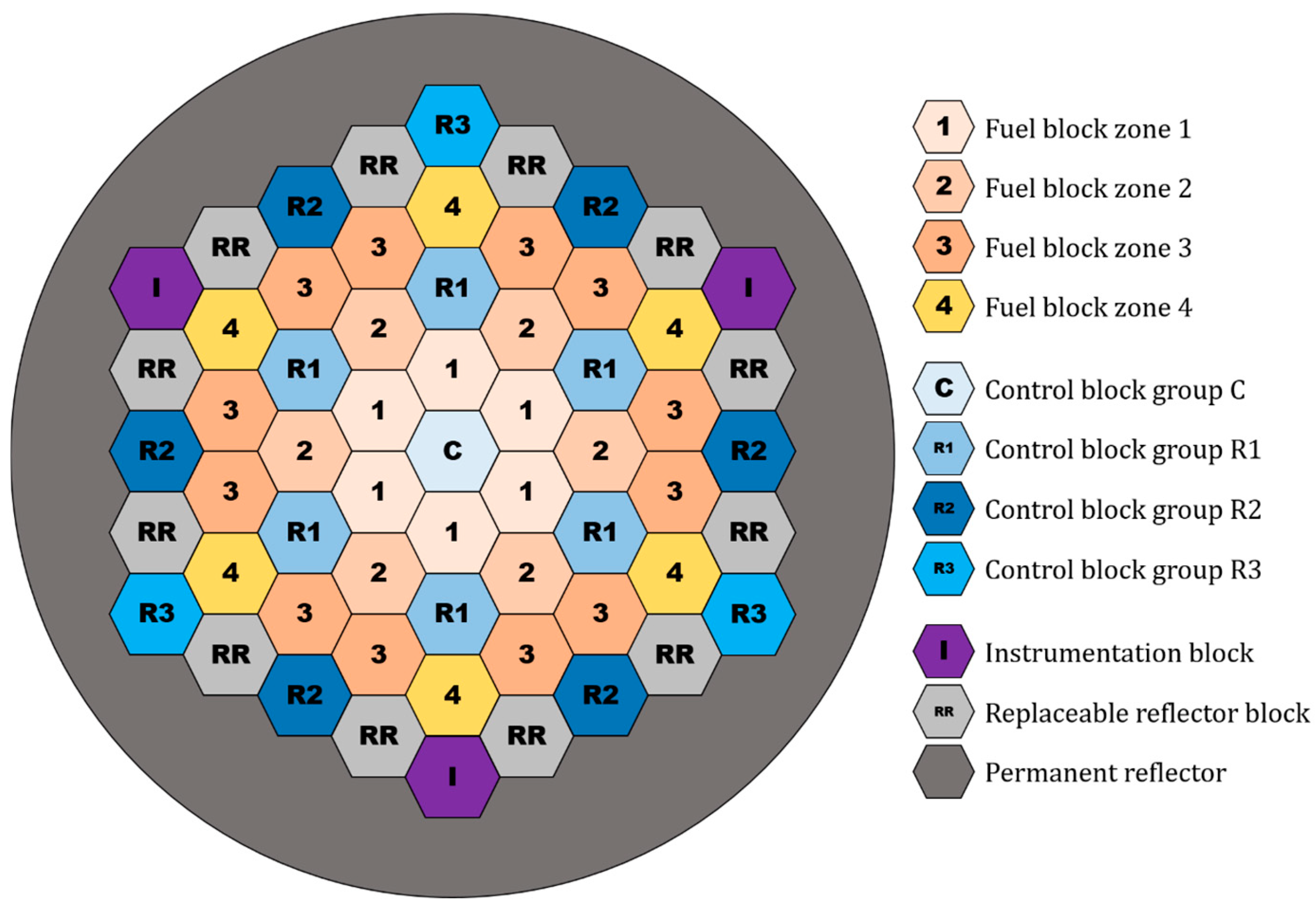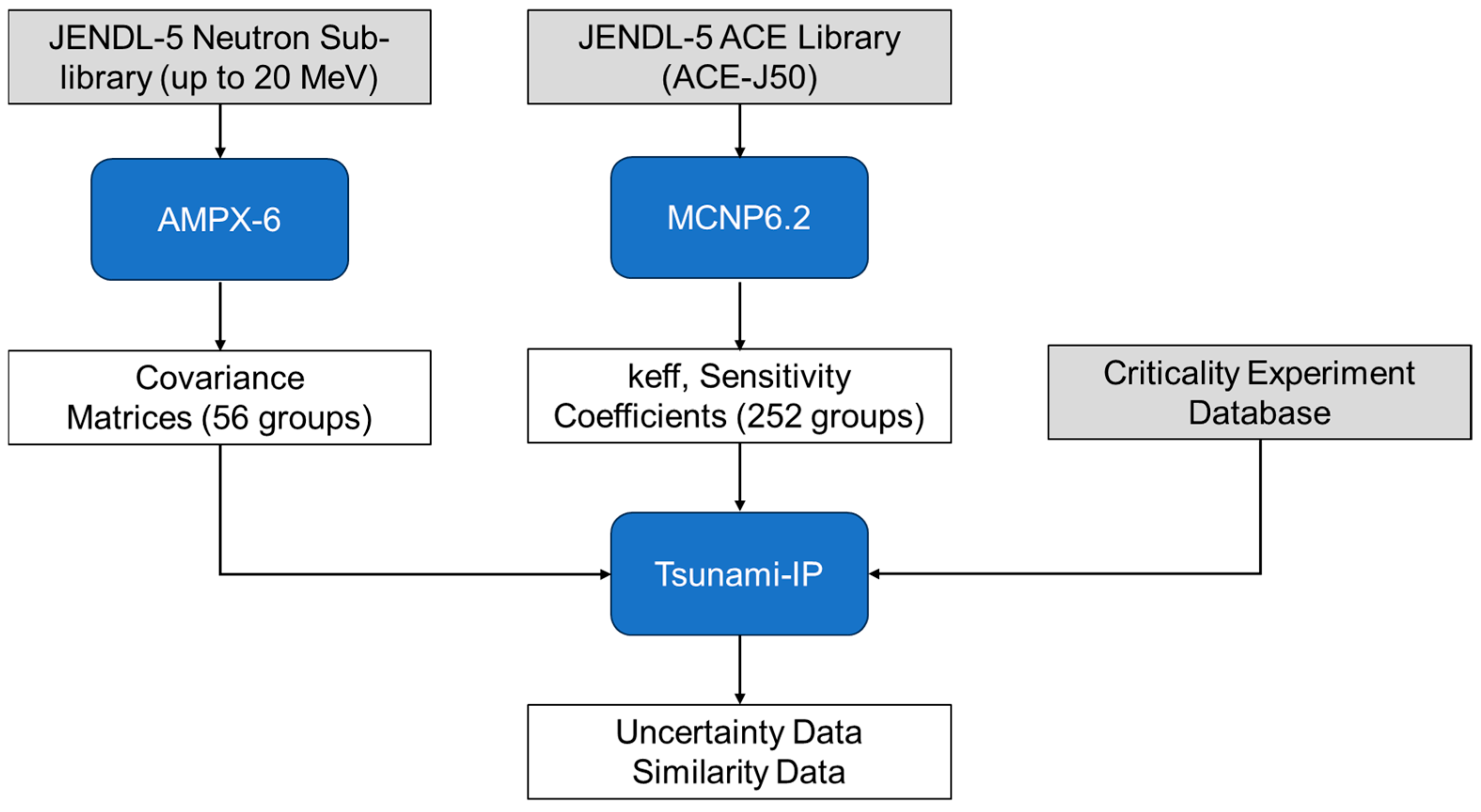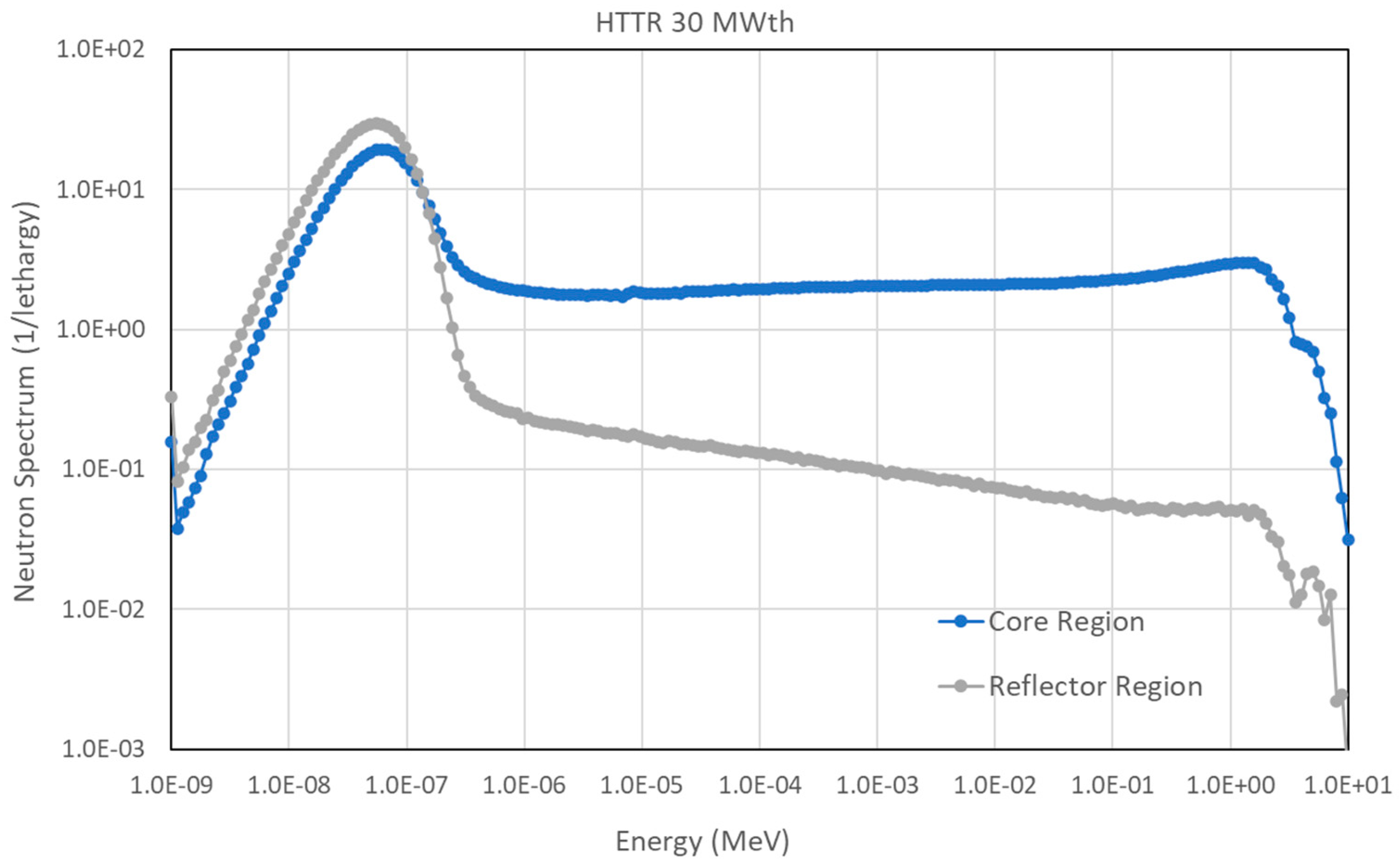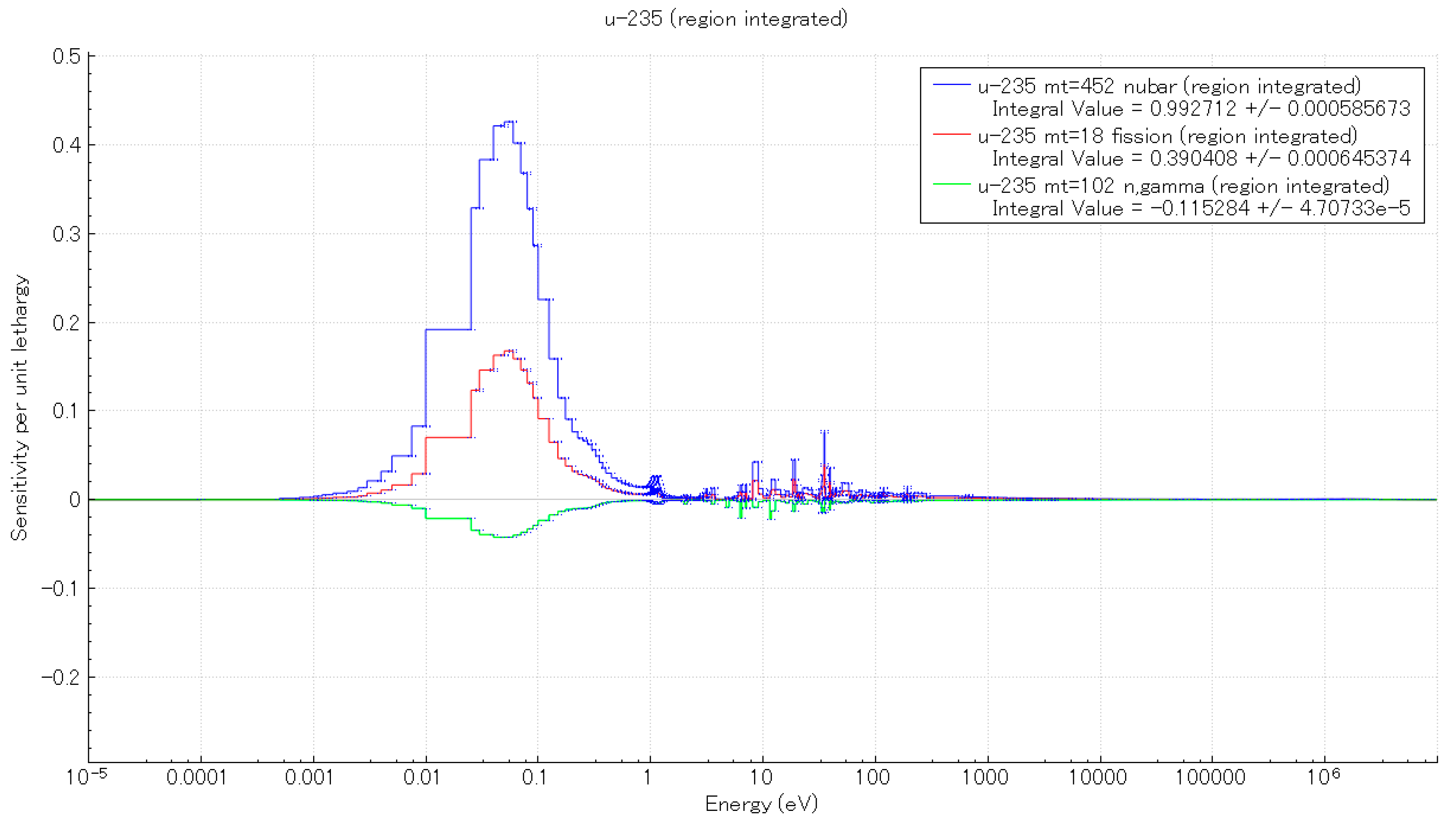The Application of JENDL-5.0 Covariance Libraries to the Keff Uncertainty Analysis of the HTTR Criticality Benchmark
Abstract
1. Introduction
2. Description of the Japanese 30 MWth HTTR Criticality Benchmarks
3. Methodology
3.1. Sensitivity, Uncertainty, and Similarity Analyses
3.2. Monte Carlo Modeling
4. Analysis Results and Discussion
4.1. Criticality Analysis
4.2. Sensitivity Analysis
4.3. Uncertainty Analysis
4.4. Similarity Analysis
4.5. Kinetics Parameter Analysis
5. Concluding Remarks
Funding
Data Availability Statement
Acknowledgments
Conflicts of Interest
References
- Iwamoto, O.; Iwamoto, N.; Kunieda, S.; Minato, F.; Nakayama, S.; Abe, Y.; Tsubakihara, K.; Okumura, S.; Ishizuka, C.; Yoshida, T.; et al. Japanese Evaluated Nuclear Data Library version 5: JENDL-5. J. Nucl. Sci. Technol. 2023, 60, 1–60. [Google Scholar] [CrossRef]
- Shibata, K.; Iwamoto, O.; Nakagawa, T.; Iwamoto, N.; Ichihara, A.; Kunieda, S.; Chiba, S.; Furutaka, K.; Otuka, N.; Ohsawa, T.; et al. JENDL-4.0: A New Library for Nuclear Science and Engineering. J. Nucl. Sci. Technol. 2011, 48, 1–30. [Google Scholar] [CrossRef]
- Iwamoto, O.; Iwamoto, N.; Shibata, K.; Ichihara, A.; Kunieda, S.; Minato, F.; Nakayama, S. Status of JENDL. In Proceedings of the 2019 International Conference on Nuclear Data for Science and Technology (ND2019), Beijing, China, 19–24 May 2019. [Google Scholar]
- Chu, T.N.; Phan, G.T.; Bui, T.H.; Do, Q.B.; Dau, D.T.; Nguyen, K.C.; Nguyen, N.D.; Nguyen, H.T.; Hoang, V.K.; Vu, T.M.; et al. Sensitivity and uncertainty analysis of the first core of the DNRR using MCNP6 and new nuclear data libraries. Nucl. Eng. Des. 2024, 419, 112986. [Google Scholar] [CrossRef]
- Ziani, H.; El Bardouni, T.; Lahdour, M.; El Barbari, M.; El Yaakoubi, H.; Boulaich, Y. Eigenvalue sensitivity and nuclear data uncertainty analysis for the Moroccan TRIGA Mark II research reactor using SCALE6.2 and MCNP6.2. Nucl. Eng. Des. 2021, 378, 111160. [Google Scholar] [CrossRef]
- Aures, A.; Berner, N.; Bousquet, J.; Velkov, K.; Zwermann, W. HELIOS-2/XSUSA sensitivity and uncertainty analyses with ENDF/B-VII.1 covariance data. Ann. Nucl. Energy 2022, 167, 108857. [Google Scholar] [CrossRef]
- Hadouachi, M.; Boukhal, H.; Chakir, E.; Belhaj, O.; Laazouzi, K.; El Yaakoubi, H.; Nouayti, A.; El Ghalbzouri, T. Nuclear data sensitivity and uncertainty analysis using a set of benchmarks containing 233U comparing ENDF/B-VII.1 and ENDF/B- VIII.0 libraries. Ann. Nucl. Energy 2024, 196, 110232. [Google Scholar] [CrossRef]
- Ahmed, A.; Boukhal, H.; El Bardouni, T.; Makhloul, M.; Chakir, E.; Ouahdani, S.E. Sensitivity and uncertainty analysis on keff due to nuclear data in the KRITZ-2:19–Comparison between JENDL-4.0 and ENDF/B-VII.1. Ann. Nucl. Energy 2019, 129, 308–315. [Google Scholar] [CrossRef]
- Wiarda, D.; Dunn, M.E.; Greene, N.M.; Williams, M.L.; Celik, C.; Petrie, L.M. AMPX-6: A Modular Code System for Processing ENDF/B; ORNL/TM-2016/43; Oak Ridge National Laboratory: Oak Ridge, TN, USA, 2016. [Google Scholar]
- Wiarda, D.; Dunn, M.E. PUFF-IV: A Code for Processing ENDF Uncertainty Data into Multigroup Covariance Matrices; ORNL/TM-2006/147/R1; Revised 2008; Oak Ridge National Laboratory: Oak Ridge, TN, USA, 2006. [Google Scholar]
- Hartanto, D.; Liem, P.H. Sensitivity and Uncertainty Analyses of a High Temperature Gas-Cooled Reactor by Using a 44-Group Covariance Library. Ann. Nucl. Energy 2021, 151, 107943. [Google Scholar] [CrossRef]
- Bess, J.D.; Fujimoto, N. Evaluation of the Start-up Core Physics Tests at Japan’s High Temperature Engineering Test Reactor (Fully-loaded Core), HTTR-GCRRESR-001, Rev. 1. In International Handbook of Evaluated Reactor Physics Benchmark Experiments; NEA/NSC/DOC(2006)1; Organisation for Economic Co-Operation and Development/Nuclear Energy Agency: Paris, France, 2010. [Google Scholar]
- Kiedrowski, B.C. Theory, Interface, Verification, Validation, and Performance of the Adjoint-Weighted Point Reactor Kinetics Parameter Calculations in MCNP; LA-UR-10-01700; Los Alamos National Laboratory: Los Alamos, NM, USA, 2010. [Google Scholar]
- Kiedrowski, B.C.; Brown, F.B.; Conlin, J.L.; Favorite, J.A.; Kahler, A.C.; Kersting, A.R.; Parsons, D.K.; Walker, J.L. Whisper: Sensitivity/Uncertainty-Based Computational Methods and Software for Determining Baseline Upper Subcritical Limits. Nucl. Sci. Eng. 2015, 181, 17–47. [Google Scholar] [CrossRef]
- Chadwick, M.B.; Herman, M.; Obložinský, P.; Dunn, M.E.; Danon, Y.; Kahler, A.C.; Smith, D.L.; Pritychenko, B.; Arbanas, G.; Arcilla, R.; et al. ENDF/B-VII.1 Nuclear Data for Science and Technology: Cross-Sections, Covariances, Fission Product Yields and Decay Data. Nucl. Data Sheets 2011, 112, 2887–2996. [Google Scholar] [CrossRef]
- Brown, F.B.; Rising, M.E. Covariance Data File Formats for Whisper-1.0 & Whisper-1.1; LA-UR-17-20098; Los Alamos National Laboratory: Los Alamos, NM, USA, 2017. [Google Scholar]
- Rearden, B.T.; Jessee, M.A. (Eds.) SCALE Code System; ORNL/TM-2005/39 Version 6.2.1; Oak Ridge National Lab. (ORNL): Oak Ridge, TN, USA, 2016. [Google Scholar]
- Liem, P.H.; Hartanto, D. JENDL-5 Nuclear Data Sensitivity, Uncertainty, and Similarity Analyses on the Criticality of RSG GAS Multipurpose Research Reactor. Nucl. Eng. Des. 2024, 418, 112899. [Google Scholar] [CrossRef]
- Bostelmann, R.; Holcomb, A.; Wiarda, D.; Wieselquist, W. On the creation of the new ENDF/B-VIII.0 Covariance Library for SCALE Applications with AMPX. In Proceedings of the International Conference on Mathematics and Computational Methods Applied to Nuclear Science and Engineering (M&C 2021), Raleigh, NC, USA, 3–7 October 2021. [Google Scholar]
- OECD/NEA. International Handbook of Evaluated Criticality Safety Benchmark Experiments; OECD Nuclear Energy Agency: Paris, France, 2016. [Google Scholar]
- OECD/NEA. International Handbook of Evaluated Reactor Physics Benchmark Experiments; OECD Nuclear Energy Agency: Paris, France, 2017. [Google Scholar]
- Rearden, B.T.; Jessee, M.A. (Eds.) Tsunami Utility Modules; ORNL/TM-2005/39 Version 6, Vol. III, Sect M18; Oak Ridge National Lab. (ORNL): Oak Ridge, TN, USA, 2009. [Google Scholar]
- Armstrong, J.; Brown, F.B.; Bull, J.S.; Casswell, L.; Cox, L.J. MCNP User’s Manual; Code Version 6.2, LA-UR-1729981; Werner, C.J., Ed.; Oak Ridge National Lab. (ORNL): Oak Ridge, TN, USA, 2017. [Google Scholar]
- Kiedrowski, B.C.; Brown, F.B. Adjoint-Based k-Eigenvalue Sensitivity Coefficients to Nuclear Data Using Continuous-Energy Monte Carlo. Nucl. Sci. Eng. 2013, 174, 227–244. [Google Scholar] [CrossRef]
- Kiedrowski, B.C.; Brown, F.B. Adjoint-Weighted Kinetics Parameters with Continuous Energy Monte Carlo. Trans. Am. Nucl. Soc. 2009, 100, 297–299. [Google Scholar]
- Wieselquist, W.A.; Lefebvre, R.A. (Eds.) SCALE 6.3.0 User Manual; ORNL/TM-SCALE-6.3.0; Oak Ridge National Lab. (ORNL): Oak Ridge, TN, USA, 2021. [Google Scholar]
- Bess, J.D.; Fujimoto, N. Benchmark Evaluation of Start-Up and Zero-Power Measurements at the High-Temperature Engineering Test Reactor. Nucl. Sci. Eng. 2014, 178, 414–427. [Google Scholar] [CrossRef]
- Strydom, G.; Bostelmann, F. Nuclear Data Uncertainty and Sensitivity Analysis of the VHTRC Benchmark Using SCALE; INL/JOU-17-42606-Revision-0; Idaho National Laboratory: Idaho Falls, ID, USA, 2017. [Google Scholar]
- Wu, Y.; Wang, L.; Wang, Y.; Guo, J.; Li, F. Sensitivity Analysis of Initial Critical State Modeling with VSOP Code. In Proceedings of the PHYSOR 2018, Cancun, Mexico, 22–26 April 2018. [Google Scholar]
- Brown, D.A.; Chadwick, M.B.; Capote, R.; Kahler, A.C.; Trkov, A.; Herman, M.W.; Sonzogni, A.A.; Danon, Y.; Carlson, A.D.; Dunn, M.; et al. ENDF/B-VIII.0: The 8-th Major Release of the nuclear reaction data library with CIELO-Project Cross Sections, New Standards and Thermal Scattering Data. Nucl. Data Sheets 2018, 148, 1–42. [Google Scholar] [CrossRef]
- Yasuda, H.; Akino, F.; Yamane, T.; Yoshihara, F.; Kitadate, K.; Yoshifuji, H.; Takeuchi, M.; Ono, T.; Kaneko, Y. Construction of VHTRC (Very High Temperature Reactor Critical Assembly); JAERI-1305; Japan Atomic Energy Research Inst: Tokai, Japan, 1987. [Google Scholar]







| Power (MWth) | 30 |
|---|---|
| Coolant inlet/outlet temperature (°C) | 395/950 |
| Primary coolant pressure (MPa) | 4 |
| Equivalent core diameter (m) | 2.3 |
| Equivalent core height (m) | 2.9 |
| Average power density (W/cm3) | 2.5 |
| Fuel | UO2 |
| U-235 enrichment (wt.%) | 3 to 10 |
| Burnup period (EFPD) | 660 |
| Fuel block (moderator) | Graphite |
| Coolant | He |
| Reflector | Graphite |
| Top (m) | 1.16 |
| Side (m) | 0.99 |
| Bottom (m) | 1.16 |
| Number of fuel assemblies | 150 |
| Number of fuel columns | 30 |
| Number of pairs of control rods | |
| In core | 7 |
| In reflector | 9 |
| Number of instrumentation columns | 3 |
| No. | ZAID | Nuclide |
|---|---|---|
| 1 | 2004 | He-4 |
| 2 | 13,027 | Al-27 |
| 3 | 14,028 | Si-28 |
| 4 | 14,029 | Si-29 |
| 5 | 14,040 | Si-30 |
| 6 | 26,054 | Fe-54 |
| 7 | 29,063 | Cu-63 |
| 8 | 29,065 | Cu-65 |
| Library | keff | FSD ** | [C/JENDL-5-1.0] |
|---|---|---|---|
| JENDL-5 | 1.01773 | 0.00008 | - |
| (1.52%) * | |||
| ENDF/B-VIII.0 *** | 1.02009 | 0.00008 | +232 pcm |
| (1.75%) * | |||
| ENDF/B-VII.1 *** | 1.01742 | 0.00008 | −30 pcm |
| (1.49%) * |
| Nuclide | Reaction | JENDL-5 | ENDF/B-VIII.0 | E80/J5 * | ENDF/B-VII.1 | E71/J5 ** |
|---|---|---|---|---|---|---|
| U-235 | total nu | 9.93 × 10−1 | 9.93 × 10−1 | 1.00 | 9.93 × 10−1 | 1.00 |
| U-235 | fission | 3.91 × 10−1 | 3.90 × 10−1 | 1.00 | 3.92 × 10−1 | 1.00 |
| C-12 | elastic | 2.35 × 10−1 | 2.62 × 10−1 | 1.12 | 2.33 × 10−1 | 0.99 |
| C (S(α,β)) | inelastic | 1.31 × 10−1 | 9.04 × 10−2 | 0.69 | 1.25 × 10−1 | 0.96 |
| C (S(α,β)) | elastic | 1.53 × 10−2 | 2.39 × 10−2 | 1.56 | 3.29 × 10−2 | 2.15 |
| U-238 | elastic | 8.94 × 10−3 | 8.25 × 10−3 | 0.92 | 8.23 × 10−3 | 0.92 |
| U-238 | total nu | 7.28 × 10−3 | 7.33 × 10−3 | 1.01 | 7.39 × 10−3 | 1.02 |
| U-238 | fission | 4.60 × 10−3 | 4.65 × 10−3 | 1.01 | 4.70 × 10−3 | 1.02 |
| Ni-58 | elastic | 2.05 × 10−3 | 2.02 × 10−3 | 0.99 | 2.08 × 10−3 | 1.01 |
| Fe-56 | elastic | 1.90 × 10−3 | 2.01 × 10−3 | 1.06 | 2.00 × 10−3 | 1.05 |
| C-12 | inelastic | 1.71 × 10−3 | 1.64 × 10−3 | 0.95 | 1.62 × 10−3 | 0.95 |
| Nuclide | Reaction | JENDL-5 | ENDF/B-VIII.0 | E80/J5 * | ENDF/B-VII.1 | E71/J5 ** |
|---|---|---|---|---|---|---|
| U-238 | n,gamma | −1.36 × 10−1 | −1.35 × 10−1 | 1.00 | −1.37 × 10−1 | 1.01 |
| U-235 | n,gamma | −1.15 × 10−1 | −1.15 × 10−1 | 1.00 | −1.14 × 10−1 | 0.99 |
| C-12 | n,gamma | −7.21 × 10−2 | −7.07 × 10−2 | 0.98 | −7.12 × 10−2 | 0.99 |
| B-10 | n,alpha | −7.08 × 10−2 | −7.10 × 10−2 | 1.00 | −7.19 × 10−2 | 1.02 |
| Si-28 | n,gamma | −2.49 × 10−3 | −2.50 × 10−3 | 1.00 | −2.52 × 10−3 | 1.01 |
| U-234 | n,gamma | −1.29 × 10−3 | −1.32 × 10−3 | 1.02 | −1.34 × 10−3 | 1.04 |
| Sensitivity Coefficients | Covariance Matrices | Uncertainty (%) |
|---|---|---|
| JENDL-5 (MCNP6.2, KSEN option, 252 group) | JENDL-5 only (AMPX-6, 56 group) | 0.387 ± 2.20 × 10−4 |
| JENDL-5 (MCNP6.2, KSEN option, 252 group) | JENDL-5 and ENDF/B-VIII.0 * (AMPX-6, 56 group) | 0.464 ± 3.27 × 10−4 |
| ENDF/B-VIII.0 (MCNP6.2, KSEN option, 252 group) | ENDF/B-VIII.0 (SCALE 6.3.1, 56 group) | 0.581 ± 2.71 × 10−4 |
| ENDF/B-VII.1 (MCNP6.2, KSEN option, 252 group) | ENDF/B-VII.1 (SCALE-6.2.3, 252 group) | 0.556 ± 2.12 × 10−4 |
| Nuclide | Reaction | With Nuclide | Reaction | % dR/R Due to This Matrix | ||
|---|---|---|---|---|---|---|
| U-235 | nubar | U-235 | nubar | 3.00 × 10−1 | ± | 3.84 × 10−5 |
| C-12 | n,gamma | C-12 | n,gamma | 2.16 × 10−1 | ± | 1.67 × 10−5 |
| U-235 | fission | U-235 | fission | 1.81 × 10−1 | ± | 4.10 × 10−5 |
| C-12 | elastic | C-12 | elastic | 1.35 × 10−1 | ± | 2.67 × 10−4 |
| U-238 | n,gamma | U-238 | n,gamma | 1.23 × 10−1 | ± | 8.36 × 10−6 |
| U-235 | chi | U-235 | chi | 8.64 × 10−2 | ± | 1.64 × 10−4 |
| U-238 | elastic | U-238 | n,gamma | 3.58 × 10−2 | ± | 3.60 × 10−5 |
| B-10 | n,alpha | B-10 | n,alpha | 3.44 × 10−2 | ± | 1.32 × 10−6 |
| U-235 | n,gamma | U-235 | n,gamma | 3.34 × 10−2 | ± | 5.32 × 10−7 |
| U-238 | elastic | U-238 | elastic | 2.88 × 10−2 | ± | 4.85 × 10−5 |
| U-235 | fission | U-235 | n,gamma | −2.77 × 10−2 | ± | 1.29 × 10−6 |
| C-12 | n,n’ | C-12 | n,n’ | 1.95 × 10−2 | ± | 3.67 × 10−5 |
| U-234 | n,gamma | U-234 | n,gamma | 1.44 × 10−2 | ± | 2.11 × 10−7 |
| C-12 | elastic | C-12 | n,n’ | −1.04 × 10−2 | ± | 5.23 × 10−6 |
| Nuclide | Reaction | With Nuclide | Reaction | % dR/R Due to This Matrix | ||
|---|---|---|---|---|---|---|
| U-235 | nubar | U-235 | nubar | 4.60 × 10−1 | ± | 6.93 × 10−5 |
| C-12 | n,gamma | C-12 | n,gamma | 2.11 × 10−1 | ± | 1.25 × 10−5 |
| U-235 | fission | U-235 | fission | 1.81 × 10−1 | ± | 3.25 × 10−5 |
| C-12 | elastic | C-12 | elastic | 1.64 × 10−1 | ± | 2.54 × 10−4 |
| U-238 | n,gamma | U-238 | n,gamma | 1.23 × 10−1 | ± | 6.53 × 10−6 |
| B-10 | n,alpha | B-10 | n,alpha | 5.51 × 10−2 | ± | 2.78 × 10−6 |
| U-238 | elastic | U-238 | n,gamma | 3.61 × 10−2 | ± | 2.88 × 10−5 |
| U-235 | n,gamma | U-235 | n,gamma | 3.36 × 10−2 | ± | 4.20 × 10−7 |
| U-238 | elastic | U-238 | elastic | 2.90 × 10−2 | ± | 3.58 × 10−5 |
| C-12 | n,n’ | C-12 | n,n’ | 1.81 × 10−2 | ± | 2.30 × 10−5 |
| U-235 | fission | U-238 | fission | 1.48 × 10−2 | ± | 6.83 × 10−7 |
| U-235 | chi | U-235 | chi | 1.39 × 10−2 | ± | 4.25 × 10−6 |
| U-235 | fission | U-235 | n,gamma | −1.04 × 10−2 | ± | 1.13 × 10−6 |
| C-12 | elastic | C-12 | n,n’ | −1.01 × 10−2 | ± | 3.69 × 10−6 |
| Nuclide | Reaction | With Nuclide | Reaction | % dR/R Due to This Matrix | ||
|---|---|---|---|---|---|---|
| U-235 | nubar | U-235 | nubar | 3.77 × 10−1 | ± | 4.32 × 10−5 |
| C | n,gamma | C | n,gamma | 2.13 × 10−1 | ± | 1.16 × 10−5 |
| U-238 | n,gamma | U-238 | n,gamma | 1.82 × 10−1 | ± | 7.74 × 10−6 |
| U-235 | n,gamma | U-235 | n,gamma | 1.62 × 10−1 | ± | 6.45 × 10−6 |
| U-235 | fission | U-235 | fission | 1.32 × 10−1 | ± | 1.50 × 10−5 |
| U-235 | fission | U-235 | n,gamma | 1.31 × 10−1 | ± | 7.88 × 10−6 |
| C | elastic | C | elastic | 1.19 × 10−1 | ± | 7.07 × 10−5 |
| U-235 | chi | U-235 | chi | 1.02 × 10−1 | ± | 1.55 × 10−4 |
| C | n,n’ | C | n,n’ | 3.73 × 10−2 | ± | 9.96 × 10−5 |
| U-238 | elastic | U-238 | n,gamma | 3.62 × 10−2 | ± | 1.43 × 10−5 |
| C | elastic | C | n,n’ | −3.19 × 10−2 | ± | 4.33 × 10−5 |
| U-238 | elastic | U-238 | elastic | 2.71 × 10−2 | ± | 2.20 × 10−5 |
| C (S(α,β)) | elastic | C (S(α,β)) | elastic | 1.41 × 10−2 | ± | 2.72 × 10−5 |
| Nuclide | Reaction | JENDL-5 | ENDF/B-VIII.0 | E80/J5 * | ENDF/B-VII.1 | E71/J5 ** |
|---|---|---|---|---|---|---|
| U-235 | nubar | 3.00 × 10−1 | 4.60 × 10−1 | 1.53 | 3.77 × 10−1 | 1.25 |
| C-12 | n,gamma | 2.16 × 10−1 | 2.11 × 10−1 | 0.98 | 2.13 × 10−1 | 0.99 |
| U-235 | fission | 1.81 × 10−1 | 1.81 × 10−1 | 1.00 | 1.32 × 10−1 | 0.73 |
| C-12 | elastic | 1.35 × 10−1 | 1.64 × 10−1 | 1.22 | 1.19 × 10−1 | 0.88 |
| U-238 | n,gamma | 1.23 × 10−1 | 1.23 × 10−1 | 1.00 | 1.82 × 10−1 | 1.47 |
| No. | Benchmark Identification | Benchmark Specification | |
|---|---|---|---|
| 1 | LEU-COMP-THERM-060-005 | 0.909 | ① RBMK Graphite Reactor: Uniform Configurations of U(1.8, 2.0, or 2.4% 235U)O2 Fuel Assemblies, and Configurations of U(2.0% 235U)O2 Assemblies with Empty Channels, Water Columns, and Boron or Thorium Absorbers, with or without Water in Channels. |
| 2 | LEU-COMP-THERM-060-006 | 0.905 | |
| 3 | LEU-COMP-THERM-060-004 | 0.899 | |
| 4 | LEU-COMP-THERM-060-003 | 0.895 | |
| 5 | LEU-COMP-THERM-060-001 | 0.888 | |
| 6 | LEU-COMP-THERM-060-002 | 0.887 | |
| 7 | LEU-COMP-THERM-008-008 | 0.799 | ② Critical Lattices of UO2 Fuel Rods and Perturbing Rods in Borated Water. |
| 8 | LEU-COMP-THERM-011-007 | 0.798 | ③ Critical Experiments Supporting Close Proximity Water Storage of Power Reactor Fuel (Part I—Absorber Rods). |
| 9 | LEU-COMP-THERM-011-003 | 0.797 | |
| 10 | LEU-COMP-THERM-008-007 | 0.796 | See ② above. |
| 11 | LEU-COMP-THERM-008-002 | 0.794 | |
| 12 | LEU-COMP-THERM-008-005 | 0.794 | |
| 13 | LEU-COMP-THERM-008-011 | 0.792 | |
| 14 | LEU-COMP-THERM-011-009 | 0.788 | See ③ above. |
| 15 | LEU-COMP-THERM-011-002 | 0.787 | |
| 16 | LEU-COMP-THERM-008-001 | 0.783 | See ② above. |
| 17 | LEU-COMP-THERM-011-015 | 0.766 | See ③ above. |
| 18 | LEU-COMP-THERM-017-004 | 0.761 | ④ Water-Moderated U (2.35) O2 Fuel Rods Reflected by Two Lead, Uranium, or Steel Walls. |
| 19 | LEU-COMP-THERM-005-004 | 0.753 | ⑤ Critical Experiments with Low-Enriched Uranium Dioxide Fuel Rods in Water Containing Dissolved Gadolinium. |
| 20 | LEU-COMP-THERM-017-006 | 0.751 | See ④ above. |
| Nuclear Data Library | Generation Time (ms.) | Rossi-Alpha (1/ms.) | Delayed Neutron Fraction (βeff) | |||
|---|---|---|---|---|---|---|
| Value | SD * | Value | SD | Value | SD | |
| JENDL-5 | 1.11843 | 0.00209 | −5.97 × 10−3 | 8.60 × 10−5 | 0.00668 | 0.00010 |
| ENDF/B-VIII.0 | 1.12404 | 0.00213 | −5.89 × 10−3 | 8.46 × 10−5 | 0.00662 | 0.00009 |
| ENDF/B-VII.1 | 1.13117 | 0.00213 | −5.83 × 10−3 | 8.31 × 10−5 | 0.00659 | 0.00009 |
Disclaimer/Publisher’s Note: The statements, opinions and data contained in all publications are solely those of the individual author(s) and contributor(s) and not of MDPI and/or the editor(s). MDPI and/or the editor(s) disclaim responsibility for any injury to people or property resulting from any ideas, methods, instructions or products referred to in the content. |
© 2025 by the author. Licensee MDPI, Basel, Switzerland. This article is an open access article distributed under the terms and conditions of the Creative Commons Attribution (CC BY) license (https://creativecommons.org/licenses/by/4.0/).
Share and Cite
Liem, P.H. The Application of JENDL-5.0 Covariance Libraries to the Keff Uncertainty Analysis of the HTTR Criticality Benchmark. J. Nucl. Eng. 2025, 6, 11. https://doi.org/10.3390/jne6020011
Liem PH. The Application of JENDL-5.0 Covariance Libraries to the Keff Uncertainty Analysis of the HTTR Criticality Benchmark. Journal of Nuclear Engineering. 2025; 6(2):11. https://doi.org/10.3390/jne6020011
Chicago/Turabian StyleLiem, Peng Hong. 2025. "The Application of JENDL-5.0 Covariance Libraries to the Keff Uncertainty Analysis of the HTTR Criticality Benchmark" Journal of Nuclear Engineering 6, no. 2: 11. https://doi.org/10.3390/jne6020011
APA StyleLiem, P. H. (2025). The Application of JENDL-5.0 Covariance Libraries to the Keff Uncertainty Analysis of the HTTR Criticality Benchmark. Journal of Nuclear Engineering, 6(2), 11. https://doi.org/10.3390/jne6020011






